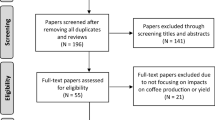Summary
The systematic and economic botany of American beans is discussed. Four species have been important food plants the main dietary role of which has been as a complementary ammo acid source in combination with corn. Beans were prominent among agricultural products cited in tribute lists in pre-Hispanic times.
Some important morphological features distinguishing the domesticates from the wild species are: increase in seed size; decrease in impermeability of seeds to water intake; reduction in fleshiness of the root system and loss of perennialism; reduction in shattering of the pods and violent seed dissemination. For the most part, the archeological materials now available do not document these changes. Excavations in the Pacific highlands and coastal areas of Mexico may be expected to yield transitional bean materials.
Archeological bean distributions do show that, unlike maize, varietal characteristics of beans have remained remarkably stable from their earliest records to their most recent. P. vulgaris, the common bean, was domesticated in Mexico by 7000 years ago; I’. coccineus, the runner bean, by 2200 years ago. P. acutifolius var. latifolius, the tepary, by 5000 years ago; P. lunatus, the sievas, or small Limas by 1400–1800 years ago, the big Limas by 5300 years ago in Peru. The present distribution of the tepary is a much contracted relic one. The tepary has been largely replaced by common beans. This process of replacement continues at the present time. Mexican sievas and Peruvian big Limas are separated throughout their archeological records, a fact that adds weight to the view that these are independently domesticated conspecific geographic races.
In the Tehuacan Valley, some kinds of beans and corn may have been domesticated in association with one another. Elsewhere, early records of corn and beans do not coincide. Although beans are pre-ceramic in the Southwest, Tamaulipas, Tehuacan and Coastal Peru, they did not become abundant in the Southwest and Middle America until agriculture was well established for some time.
Similar content being viewed by others
References
Albanese, Anthony A. 1959. Protein and amino acid nutrition. Academic Press, New York.
Altschul, Aaron M. 1962. Seed proteins and world food problems. Econ Bot.16: 2–13.
Block, Richard J., and Kathryn W. Weiss. 1956. Amino acid handbook. Charles C. Thomas, Springfield, Illinois.
Brooks, R. H., L. Kaplan, H. C. Cutler, and T. W. Whitaker. 1962. Plant material from a cave on the Rio Zape, Durango, Mexico. Am. Antiquity27: 356–369.
Bukasov, S. M. 1930. Cultivated plants of Mexico, Guatemala, and Colombia. Bull. Appl. Bot. Gen. and Plant. Breeding Suppl.47: 151–176. Leningrad. [Mss. translation by H. J. Kidd.]
Carlson, Roy L. 1963. Basketmaker III sites near Durango, Colorado. The Earl Morris Papers. No. 1. University of Colorado Studies, Series in Anthropology, No. 8, Part LV. Faunal and Floral Remains.
Chatfield, Charlotte, and Georgian Adams. 1940. Proximate composition of American food materials. U. S. Dept. of Agric. Circ. 549.
Clark, James Cooper, Ed. and Trans. 1938. Codex Mendoza, the Mexican Manuscript known as the Collection of Mendoza and preserved in the Bodleian Library Oxford. Three volumes, Waterlow and Sons, Ltd., London.
Cutler, Hugh C., and Thomas J. Whitaker. 1961. History and distribution of the cultivated cucurbits in the Americas. Am. Antiquity26: 469–485.
Ellis, G. P. 1959. The Maillard Reaction. Adv. Carbohydrate Chem.14: 63–134.
Freeman, G. F. 1912. Southwestern beans and teparies. Univ. of Ariz. Agric. Expt. Station, Bull. 68.
Jones, D. B., C. E. F. Gorsdorff, and Sammie Phillips. 1938. Jour, of Biol. Chem.122: 745–755.
Kaplan, L. 1956. The cultivated beans of the prehistoric southwest. Ann. Mo. Bot. Gard.43: 189–251.
Kaplan, L., and R. S. MacNeish. 1960. Prehistoric bean remains from caves in the Ocampo region of Tamaulipas, Mexico. Bot. Mus. Leafl., Harvard Univ.19(2): 33–56.
Kyle, Jack H., and T. E. Randall. 1963. A new concept of the hard seed character inPhaseolus vulgaris L. and its use in breeding and inheritance studies. Proc. Amer. Soc. Hort. Sci.83: 461–475.
Lowe, Richard T. 1868. A manual flora of Madeira. London.
Mackie, W. W. 1943. Origin, dispersal and variability of the lima bean,Phaseolus lunatus.Hilgardia 15: 1–24.
MacNeish, Richard S. 1962. Second annual report of the Tehuacan Archeological-Botanical project, Robert S. Peabody Foundation for Archeology, Andover, Mass.
Mangelsdorf, Paul C., R. S. MacNeish, and Walton C. Galinat. 1964. Domestication of corn. Science.143(3606): 538–545.
Martin, Paul S., J. B. Rinaldo, E. Bluhm, H. C. Cutler, and R. Grange, Jr. 1952. Mogollon cultural continuity and change. Fieldiana: Anthropology. 40.
Peterson, F. A. 1962. Ancient Mexico, Capricorn Books Edition, Great Britain.
Piper, C. V. 1926. Studies of American Phaseolinae. Smithsonian Inst. U. S. Natl. Mus. Contrib. U. S. Natl. Her.22: 663–701.
Towle, Margaret A. 1961. The ethnobotany of Pre-Colombian Peru. Viking Fund Publications in Anthropology, No. 30. Wenner Gren Foundation for Anthropological Research, Inc. New York.
Willis, J. C. 1951. Dictionary of the flowering plants and ferns. Cambridge University Press. 6th ed. rev. Cambridge.
Wolf, E. R. 1959. Sons of the shaking earth. University of Chicago Press, Chicago and London.
Yarnell, R. A. 1964. Aboriginal relationships between cultures and plant life in the Upper Great Lakes Region. Anthropological Papers, Museum of Anthropology, Univ. of Michigan No. 23. Ann Arbor.
Author information
Authors and Affiliations
Rights and permissions
About this article
Cite this article
Kaplan, L. Archeology and domestication in American Phaseolus (Beans). Econ Bot 19, 358–368 (1965). https://doi.org/10.1007/BF02904806
Received:
Issue Date:
DOI: https://doi.org/10.1007/BF02904806




